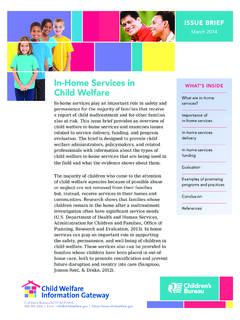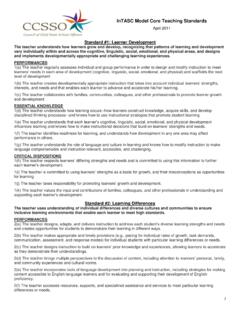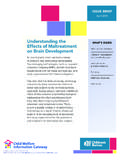Transcription of Using Positive Student Engagement to Increase Student ...
1 NEWSLETTER April | 2007 Using Positive Student Engagement to Increase Student aChiEvEmEnT Teachers and school-based administrators alike have searched to find ways to Increase Student achievement in their schools. Several widely known and discussed strategies include Using data to drive instruction, employing highly qualified teachers, and improving school leadership. Additionally, Positive Student Engagement in the classroom is another compelling factor but not as widely discussed that research has reported to be critical in enhancing Student achievement (Akey, 2006; Heller, Calderon, & Medrich, 2003; Garcia-Reid, Reid, & Peterson, 2005). Positive Student Engagement is not an easy term to define, yet we know it when we see it. Students are engaged when they devote substantial time and effort to a task, when they care about the quality of their work, and when they commit themselves because the work seems to have significance beyond its personal instrumental value (Newmann, 1986, p.)
2 242). Engaged students also are more likely to perform well academically. Therefore, teachers need a large inventory of instructional strategies to engage a variety of students (Garcia-Reid et al., 2005). For additional information on these topics, see The Center s January 2007 newsletter, A Teacher s Guide to Differentiating Instruction ( ). This newsletter describes how Student Engagement impacts learning and outlines ways in which teachers and school administrators can foster Student Engagement . What Can Teachers Do to Foster Positive Student Engagement in the Classroom? Teachers are key players in fostering Student Engagement (Akey, 2006; Garcia-Reid et al., 2005). They work directly with the students and typically are the most influential in a Student s educational experience. Creating a culture of achievement in their classroom, developing interactive and relevant lessons and activities, and being encouraging and supportive to students are all ways in which teachers can foster Student Engagement in the classroom.
3 NEWSLETTERC ultivate a Culture of Achievement One method of enhancing Student Engagement is to cultivate a culture of achievement in the classroom where instruction is challenging, students feel comfortable asking questions, and students are expected to do their best. For instance, a teacher might create an end-of-the-year academic goal for a classroom as a whole or a specific goal for each individual Student .
4 In order to show mastery of the goal, students must complete a research project or an oral presentation. For example, students might be asked to research a critical political issue such as immigration impacting the 2008 elections. Teachers need to select a goal that is challenging but attainable and find creative ways for students to work toward achieving the goal. Monitoring Student progress throughout the school year also will keep students focused academically and invested in their learning. When students feel challenged, they are less likely to be bored and disengaged (Akey, 2006). Teachers should aim to create a culture in the classroom where learning is cool, and asking questions is not only okay but expected. It may take some time to develop this type of environment, but it can be done by setting clear, high, consistent yet attainable expectations for all students. High quality instruction one that is rigorous, aligned with content standards, and uses instructional strategies to meet the academic needs of all students also is a key factor in promoting a culture of Engagement and achievement in the classroom (Weiss & Pasley, 2004).
5 Concentrate on Active Learning and a Relevant Curriculum Instructional strategies such as collaborative learning and experiential learning as well as designing an accessible and relevant curriculum have been shown to greatly Increase Student Engagement in learning (Akey, 2006; Heller et al., 2003). Examples of these instructional strategies that might support Student Engagement include the following: Group activities and assignments Long-term projects Hands-on activities Differentiated instruction Lessons and activities that draw from students background, interests, and academic needs Students learn more and retain more information when they actively participate in the learning process and when they can relate to what is being taught (Akey, 2006). Drawing connections between information taught and real life such as everyday life, social issues, and personal concerns of the age group of students is highly effective in engaging students in the lesson (Heller et al.)
6 , 2003). For instance, a middle school English teacher might select persuasive writing topics that preteens can easily relate to or a high school physics teacher might use roller coasters to reinforce Newton s Law of Motion. Research states that the extent to which students interests are incorporated is significantly related to their academic achievement (Heller et al., 2003, p. 12). Research also has shown that the inclusion of students interests in the learning process increases Student Engagement in learning (Akey, 2006; Heller et al., 2003). Therefore, Positive Student Engagement can positively impact Student achievement. Offer Support and Encouragement Additionally, Student Engagement is positively correlated to teacher support (Akey, 2006; Garcia-Reid et al., 2005). Several studies have found that students who noted that their teachers were supportive and cared about their success were more likely to be engaged in the classroom and perform well academically (Heller et al.
7 , 2003; Akey, 2006). One study found that students who do not feel confident in their ability to succeed are not likely to attempt to do the work (Akey, 2006). Building a Student s confidence is not about falsely telling students how great they are. Instead, it is about assessing Student weaknesses and strengths and developing ways to address them at developmentally appropriate yet rigorous levels. Additionally, acknowledging Student academic growth and improvement is another way to build Student confidence. It is crucial for teachers to create collaborative, supportive environments with high but achievable standards because it greatly effects students Engagement in school and learning (Akey, 2006, p. 32.) how Can Schools help? It is important to note that there are many environmental factors poverty, neighborhood violence, family discord that may contribute to Student disengagement, but there are several interventions that school administrators can implement to reduce the effects of negative outside influences and in turn encourage Positive Student Engagement in learning (Garcia-Reid et al.
8 , 2005; Warner, Weisst, & Krulak, 1999). Interventions such as increasing parental involvement, offering extracurricular activities, and improving school safety may enhance Student Engagement in the classroom. Increase Parental Involvement Parental support is directly linked to Student Engagement in learning especially among African-American and Latino youth (Garcia-Reid et al., 2005; Richman, Rosenfeld, & Bowen, 1998). Therefore, schools must break down any barriers that impede parental involvement and work diligently to Increase parental interaction at school and with their children s schoolwork (Garcia-Reid et al., 2005). Schools can do this by creating a welcoming and inviting environment at the school for parents, providing opportunities for parents to collaborate with the school and/or teachers to identify support needs of the students, and keeping the lines of communication open. An example of open lines of communication is ensuring that schools with high English language learner or ethnic minority populations develop cultural and linguistically specific information (Garcia-Reid et al.
9 , 2005). However, it is important to note that parents do not have to be in the schools to be involved in their child s learning; they can offer substantial support from home by reinforcing the importance of completing homework or attending classes. Additional information regarding this topic is available from The Center s September 2006 newsletter, What Schools Want Parents to Know ( ). Focus on School Safety Students who do not feel safe in school tend to have difficulty concentrating in class and retaining what was taught (Garcia-Reid et al., 2005). Therefore, schools need to create a safe refuge for students in the school. School leaders should set clear behavior expectations for students and encourage teachers and other staff to model expected behavior (Noonan, 2004). There are actions that a school could implement to sustain a safe, orderly, and equitable learning environment, including the following (Noonan, 2004; Spellings 2006): Consistent and nondiscriminatory enforcement of school disciplinary action codes.
10 Accessibility to support staff, including school-based security personnel, counselors, and community volunteers. Violence prevention programs where students learn how to avoid and/or properly respond to confrontations. School safety is a key component in ensuring that students are schooled in an environment that allows them to focus on educational activities. Offer Extracurricular Activities Student Engagement in the classroom also is related to participation in extracurricular activities, especially among students from low-income families (Fredricks & Eccles, 2006). The authors say students who are involved in extracurricular activities outside the normal school day have been found to be more engaged in the classroom. Extracurricular activities provide students with an opportunity to develop a Positive support system among their peers and adult staff, which also are key components of fostering Student Engagement in the classroom (Heller et al.)
















